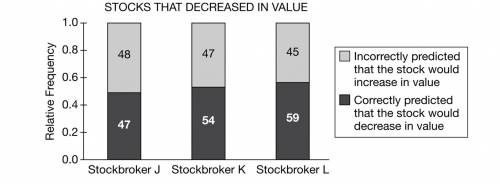
Advanced Placement (AP), 12.04.2021 01:00 wichserc3399
An investment company is looking to hire one of three different stockbrokers (J, K, and L). In order to measure their ability to predict the future value of stocks, each stockbroker will be given historical data on a set of stocks and then asked to predict whether each stock increased or decreased in value within a certain time period.
The investment company has access to a large database of historical stock performance data. A random sample of 500 stocks that were known to have increased in value during the time period is selected. Each stock was then randomly assigned to one of the three stockbrokers. The table shows the number of stocks correctly predicted to increase in value and incorrectly predicted to decrease in value for each stockbroker.
(a) Compare the relative frequencies of stocks correctly predicted to increase in value for each stockbroker to determine which is highest.
The investment company selected a second random sample of 300 stocks that were known to have decreased in value during the time period. Each stock was then randomly assigned to one of the three stockbrokers. The segmented bar graph shows the distribution of the number of stocks correctly predicted to decrease in value and incorrectly predicted to increase in value for each stockbroker.
(b) Write a few sentences describing what the graph reveals about the association between stockbroker and prediction accuracy among the 300 stocks that decreased in value.
(c) For each stockbroker, give a statistical reason why the investment company might choose to hire the stockbroker to make predictions about the future value of stocks. Do not perform an inferential procedure.
The investment company plans to use the sample data to investigate whether there is convincing statistical evidence, at α=0.10, that the proportion of stocks that would be correctly predicted to increase in value by Stockbroker J is greater than the proportion of stocks that would be correctly predicted to decrease in value by Stockbroker J.
(d) Name the appropriate test and state, in words, the hypotheses.
(e) State the conditions for the appropriate test, and explain why the conditions are met.
(f) The test statistic for the appropriate test is 1.375 (increased minus decreased). Based on the result of the hypothesis test, what conclusion should the investment company make? Justify your answer.



Answers: 3


Another question on Advanced Placement (AP)

Advanced Placement (AP), 24.06.2019 02:00
Which one of the following is not a good procedure to follow if you wish to avoid being rear ended by another vehicle
Answers: 1

Advanced Placement (AP), 24.06.2019 10:30
Scientists are studying hurricanes to determine the number of hurricanes in the past 50 years that have caused greater than $1 million in damages. which best describes the population? hurricanes hurricanes that caused greater than $1 million in damages scientists scientists participating in the research
Answers: 3

Advanced Placement (AP), 25.06.2019 00:00
Which of the following statements is true about taste bud preferences? a. taste buds respond exclusively to a certain taste sensation, like saltiness. b. taste buds have the ability to respond to all of the taste sensations. c. taste buds do not differentiate between bitter and salty sensations. d. taste buds have the capability to detect three taste sensations.
Answers: 1

Advanced Placement (AP), 25.06.2019 14:10
Among the following environmental factors, which does not have a long-term impact on the composition of a region's soil? a. kinds of crops grown b. types of fungi present c. topography of the landscape d. variety of species of mammals e. number of freezes occurring annually
Answers: 1
You know the right answer?
An investment company is looking to hire one of three different stockbrokers (J, K, and L). In order...
Questions




Biology, 07.07.2019 14:00



English, 07.07.2019 14:00




Mathematics, 07.07.2019 14:00





Mathematics, 07.07.2019 14:00




Social Studies, 07.07.2019 14:00



